Evolution of the Upper Yellow River as Revealed by Changes in Heavy-Mineral and Geochemical (REE) Signatures of Fluvial Terraces (Lanzhou, China)
Abstract
1. Introduction
2. Yellow River Terraces in the Lanzhou Area
3. Sampling and Methods
4. Results
4.1. Heavy-Mineral Assemblages
4.2. Rare Earth Elements
5. Discussion
6. Conclusions
Author Contributions
Funding
Acknowledgments
Conflicts of Interest
References
- Milliman, J.D.; Meade, R.H. World-wide delivery of river sediment to the oceans. J. Geol. 1983, 91, 1–21. [Google Scholar] [CrossRef]
- Ren, M.E. Sediment discharge of the Yellow River, China: Past, present and future-A synthesis. Acta Oceanol. Sin. 2015, 34, 1–8. [Google Scholar] [CrossRef]
- Li, J.J. The environmental effects of the uplift of the Qinghai-Xizang Plateau. Quat. Sci. Rev. 1991, 10, 479–483. [Google Scholar] [CrossRef]
- Harkins, N.; Kirby, E.; Heimsath, A.; Robinson, R.; Reiser, U. Transient fluvial incision in the headwaters of the Yellow River, northeastern Tibet, China. J. Geophys. Res. 2007, 112, F03S04. [Google Scholar] [CrossRef]
- Lease, R.O.; Burbank, D.W.; Gehrels, G.E.; Wang, Z.C.; Yuan, D.Y. Signatures of mountain building: Detrital zircon U/Pb ages from northeastern Tibet. Geology 2007, 35, 239–242. [Google Scholar] [CrossRef]
- Hu, Z.B.; Pan, B.T.; Guo, L.Y.; Vandenbergheb, J.; Liu, X.P.; Wang, J.P.; Fan, Y.L.; Mao, J.W.; Gao, H.S. Rapid fluvial incision and headward erosion by the Yellow River along the Jinshaan gorge during the past 1.2 Ma as a result of tectonic extension. Quat. Sci. Rev. 2016, 133, 1–14. [Google Scholar] [CrossRef]
- Hu, Z.B.; Pan, B.T.; Bridgland, D.; Vandenberghe, J.; Guo, L.Y.; Fan, Y.L.; Westaway, R. The linking of the upper-middle and lower reaches of the Yellow River as a result of fluvial entrenchment. Quat. Sci. Rev. 2017, 166, 324–338. [Google Scholar] [CrossRef]
- Wang, W.T.; Zhang, P.Z.; Liu, C.K.; Zheng, D.W.; Yu, J.X.; Zheng, W.J.; Wang, Y.Z.; Zhang, H.P.; Chen, X.Y. Pulsed growth of the West Qinling at ~30 Ma in northeastern Tibet: Evidence from Lanzhou Basin magneostratigraphy and provenance. J. Geophys. Res.-Solid Earth 2016, 121, 7754–7774. [Google Scholar] [CrossRef]
- Pang, H.L.; Pan, B.T.; Garzanti, E.; Gao, H.S.; Zhao, X.; Chen, D.B. Mineralogy and geochemistry of modern Yellow River sediments: Implications for wreathing and provenance. Chem. Geol. 2018, 488, 76–86. [Google Scholar] [CrossRef]
- Pan, B.T.; Su, H.; Hu, Z.B.; Hu, X.F.; Gao, H.S.; Li, J.J.; Kirby, E. Evaluating the role of climate and tectonics during non-steady incision of the Yellow River: Evidence from a 1.24 Ma terrace record near Lanzhou, China. Quat. Sci. Rev. 2009, 28, 3281–3290. [Google Scholar] [CrossRef]
- Pan, B.T. Problems on the Development of the Yellow River and Uplift of Qinghai-Xizang Plateau. Ph.D. Thesis, Lanzhou University, Lanzhou, China, 1991. (In Chinese). [Google Scholar]
- Craddock, W.H.; Kirby, E.; Harkins, W.N.; Zhang, H.P.; Shi, X.H.; Liu, J.H. Rapid fluvial incision along the Yellow River during headward basin integration. Nat. Geosci. 2010, 3, 209–213. [Google Scholar] [CrossRef]
- Perrineau, A.; Van Der Woerd, J.; Gaudemer, Y.; Zeng-Liu, J.; Pik, P.; Tapponnier, P.; Thuizat, R.; Zheng, R.Z. Incision rate of the Yellow River in Northeastern Tibet constrained by 10Be and 26Al cosmogenic isotope dating of fluvial terraces: Implications for catchment evolution and plateau building. Geol. Soc. Lond. Spec. Publ. 2011, 353, 189–219. [Google Scholar] [CrossRef]
- Kong, P.; Jia, J.; Zheng, Y. Time constraints for the Yellow River traversing the Sanmen Gorge. Geochem. Geophy. Geosyst. 2014, 15, 395–407. [Google Scholar] [CrossRef]
- Zhang, J.; Huang, W.W.; Liu, M.G.; Zhou, Q. Drainage basin weathering and major element transport of two larger Chinese river (Huanghe and Changjiang). J. Geophy. Res. 1990, 95, 13277–13288. [Google Scholar] [CrossRef]
- Yang, S.Y.; Li, C.X. Research progress in REE trace for sediment source. Adv. Earth Sci. 1999, 14, 164–167. (In Chinese) [Google Scholar]
- Yang, S.Y.; Li, C.X.; Jung, H.S.; Lee, H.J. Discrimination of geochemical compositions between the Changjiang and the Huanghe sediments and its application for the identification of sediment source in the Jiangsu coastal plain, China. Mar. Geol. 2002, 186, 229–241. [Google Scholar] [CrossRef]
- Nie, J.S.; Stevens, T.; Rittner, M.; Stockli, D.; Garzanti, E.; Limonta, M.; Bird, A.; Andò, S.; Vermeesch, P.; Saylor, J.; et al. Loess Plateau storage of northeastern Tibetan Plateau-derived Yellow River sediment. Nat. Commun. 2015, 6, 8511. [Google Scholar] [CrossRef] [PubMed]
- Pan, B.T.; Pang, H.L.; Gao, H.S.; Garzanti, E.; Zou, Y.; Liu, X.P.; Li, F.Q.; Jia, Y.X. Heavy-mineral analysis and provenance of Yellow River sediments around the China Loess Plateau. J. Asian Earth Sci. 2016, 127, 1–11. [Google Scholar] [CrossRef]
- Jin, B.F.; Wang, M.Y.; Yue, W.; Zhang, L.N.; Wang, Y.J. Heavy Mineral Variability in the Yellow River Sediments as Determined by the Multiple-Window Strategy. Minerals 2019, 9, 85. [Google Scholar] [CrossRef]
- Guo, B.H.; Liu, S.P.; Peng, T.J.; Ma, Z.H.; Feng, Z.T.; Li, M.; Li, X.M.; Li, J.J.; Song, C.H.; Zhao, Z.J.; et al. Late Pliocene establishment of exorheic drainage in the northeastern Tibetan Plateau as evidenced by the Wuquan Formation in the Lanzhou Basin. Geomorphology 2018, 303, 271–283. [Google Scholar] [CrossRef]
- Che, X.D.; Li, G.J. Binary sources of loess on the Chinese Loess Plateau revealed by U-Pb ages of zircon. Quat. Res. 2013, 80, 545–551. [Google Scholar] [CrossRef]
- Licht, A.; Pullen, A.; Kapp, P.; Abell, J.; Giesler, N. Eolian cannibalism: Reworked loess and fluvial sediment as the main sources of the Chinese Loess Plateau. Geol. Soc. Am. Bull. 2016, 128, 944–956. [Google Scholar] [CrossRef]
- Garzanti, E.; Andò, S. Plate tectonics and heavy-mineral suites of modern sands. Dev. Sedimentol. 2007, 58, 741–763. [Google Scholar] [CrossRef]
- Morton, A.C.; Hallsworth, C. Stability of detrital heavy minerals during burial diagenesis. Dev. Sedimentol. 2007, 58, 215–245. [Google Scholar] [CrossRef]
- Taylor, S.R.; McLennan, S.M. The Continental Crust: Its Composition and Evolution; Blackwell Scientific Publications: Oxford, UK, 1985; p. 312. [Google Scholar]
- Cullers, R.L. Implication of elemental concentrations for provenance, redox conditions, and metamorphic studies of shales and limestones near Pueblo, CO, USA. Chem. Geol. 2002, 191, 305–327. [Google Scholar] [CrossRef]
- Moreno, T.; Querol, X.; Castillo, S.; Alastuey, A.; Cuevas, E.; Herrmann, L.; Mounkaila, M.; Elvira, J.; Gibbons, W. Geochemical variations in aeolian mineral particles from the Sahara-Sahel Dust Corridor. Chemosphere 2006, 65, 261–270. [Google Scholar] [CrossRef] [PubMed]
- Roy, P.D.; Smykatz-Kloss, W. REE geochemistry of the recent playa sediments from the Thar desert, India: An implication to play a sediment provenance. Chemie der Erde-Geochemistry 2007, 67, 55–68. [Google Scholar] [CrossRef]
- Castillo, S.; Moreno, T.; Querol, S.; Alastuey, A.; Cuevas, E.; Herrmann, L.; Mounkaila, M.; Gibbons, W. Trace element variation in size-fractionated African desert dusts. J. Arid Environ. 2008, 72, 1034–1045. [Google Scholar] [CrossRef]
- Kasper-Zublillaga, J.J.; Acevedo-Vargas, B.; Bermea, O.M.; Zamora, G.O. Rare earth elements of the Altar Desert dune and coastal sands, Northwestern Mexico. Chemie der Erde-Geochemistry 2008, 68, 45–59. [Google Scholar] [CrossRef]
- Wang, P.; Jiang, H.C.; Yuan, D.Y.; Liu, X.W.; Zhang, B. Optically stimulated luminescence dating of sediments from the Yellow River terraces in Lanzhou: Tectonic and climatic implications. Quat. Geochronol. 2010, 5, 181–186. [Google Scholar] [CrossRef]
- Miao, Y.F.; Wu, F.L.; Herrmann, M.; Yan, X.L.; Meng, Q.Q. Late early Oligocene East Asian summer monsoon in the NE Tibetan Plateau: Evidence from a palynological record from the Lanzhou Basin China. J. Asian Earth Sci. 2013, 75, 46–57. [Google Scholar] [CrossRef]
- Yue, L.P.; Heller, F.; Qiu, Z.X.; Zhang, L.; Jie, G.P.; Qiu, Z.D.; Zhang, Y.X. Magnetostratigraphy and paeleo-environmental record of Tertiary deposits of Lanzhou Basin. Chin. Sci. Bull. 2001, 46, 770–773. [Google Scholar] [CrossRef]
- Zhang, L.Y. Preliminary study on Quaternary geology of Lanzhou valley basin. J. Lanzhou Univ. 1962, 2, 89–98. (In Chinese) [Google Scholar]
- Chen, J.F. Study on Landform Development Model at Longzhong Basin since Late Pliocene. Master’s Thesis, Lanzhou University, Lanzhou, China, 2010. (In Chinese). [Google Scholar]
- Zhu, J.J.; Zhong, W.; Li, J.J.; Cao, J.X.; Wang, J.L. The oldest eolian loess deposition in the Longxi Basin-Yandonggou profile in Lanzhou. Sci. Geogr. Sin. 1996, 16, 365–369. (In Chinese) [Google Scholar]
- Hu, X.F.; Kirby, E.; Pan, B.T.; Granger, D.E.; Su, H. Cosmogenic burial ages reveal sediment reservoir dynamics along the Yellow River, China. Geology 2011, 39, 839–842. [Google Scholar] [CrossRef]
- Nie, J.S.; Peng, W.B.; Pfaff, K.; Möller, A.; Garzanti, E.; Andò, S.; Stevens, T.; Bird, A.; Chang, H.; Song, Y.G.; et al. Controlling factors on heavy mineral assemblages in Chinese loess and Red Clay. Palaeogeogr. Palaeoclimatol. Palaeoecol. 2013, 381–382, 110–118. [Google Scholar] [CrossRef]
- Nie, J.S.; Peng, W.B. Automated SEM-EDS heavy mineral analysis reveals no provenance shift between glacial loess and interglacial paleosol on the Chinese Loess Plateau. Aeolian Res. 2014, 13, 71–75. [Google Scholar] [CrossRef]
- Peng, W.B.; Wang, Z.; Song, Y.G.; Pfaff, K.; Luo, Z.; Nie, J.S.; Chen, W.H. A comparison of heavy mineral assemblage between the loess and the Red Clay sequences on the Chinese Loess Plateau. Aeolian Res. 2016, 21, 87–91. [Google Scholar] [CrossRef]
- McLennan, S.M. Relationships between the trace element composition of sedimentary rocks and upper continental crust. Geochem. Geophy. Geosyst. 2001, 2, 2000GC000109. [Google Scholar] [CrossRef]
- Yang, S.; Li, C.; Lee, C.B.; Na, T.K. REE geochemistry of suspended sediments from the rivers around the Yellow Sea and provenance indicators. Chin. Sci. Bull. 2003, 48, 1135–1139. [Google Scholar] [CrossRef]
- Singh, P. Major, trace and REE geochemistry of the Ganga River sediments: Influence of provenance and sedimentary processes. Chem. Geol. 2009, 266, 251–264. [Google Scholar] [CrossRef]
- Fleet, A.J. Aqueous and sedimentary geochemistry of the rare earth elements. In Developments in Geochemistry; Elsevier: Amsterdam, The Netherlands, 1984; Volume 2, pp. 343–374. [Google Scholar]
- Garzanti, E.; Padoan, M.; Setti, M.; López-Galindo, A.; Villa, I.M. Provenance versus weathering control on the composition of tropical river mud (southern Africa). Chem. Geol. 2014, 366, 61–74. [Google Scholar] [CrossRef]
- Garzanti, E.; Vezzoli, G.; Andò, S.; Castiglioni, G. Petrology of rifted-margin sand (Red Sea and Gulf of Aden, Yemen). J. Geol. 2001, 109, 277–297. [Google Scholar] [CrossRef]
- Andò, S.; Morton, A.; Garzanti, E. Metamorphic grade of source rocks revealed by chemical fingerprints of detrital amphibole and garnet. Geol. Soc. Lond. Spec. Publ. 2014, 386, 351–371. [Google Scholar] [CrossRef]
- He, T.; Liu, L.W.; Chen, Y.; Sheng, X.F.; Ji, J.F. A seven-million-year hornblende mineral record from the central Chinese Loess Plateau. Sci. Rep. 2017, 7, 2382. [Google Scholar] [CrossRef]
- Sun, Y.B.; Clemens, S.C.; An, Z.S.; Yu, Z.W. Astronomical timescale and palaeoclimatic implication of stacked 3.6-Myr monsoon records from the Chinese Loess Plateau. Quat. Sci. Rev. 2006, 25, 33–48. [Google Scholar] [CrossRef]
- Lisiecki, L.E.; Raymo, M.E. A Plio-Pleistocene stack of 57 globally distributed benthic δ18O records. Paleoceanography 2005, 20, PA1003. [Google Scholar] [CrossRef]
- Wang, Z.; Nie, J.S.; Wang, J.P.; Zhang, H.B.; Peng, W.B.; Garzanti, E.; Hu, X.F.; Stevens, T.; Pfaff, K.; Pan, B.T. Testing contrasting models of the formation of the upper Yellow River using heavy-mineral data from the Yinchuan Basin drill cores. Geophys. Res. Lett. 2019, 46. [Google Scholar] [CrossRef]
- Garzanti, E.; Andò, S.; France-Lanord, C.; Vezzoli, G.; Censi, P.; Galy, V.; Najman, Y. Mineralogical and chemical variability of fluvial sediments: 1. Bedload sand (Ganga–Brahmaputra, Bangladesh). Earth Planet. Sci. Lett. 2010, 299, 368–381. [Google Scholar] [CrossRef]
- Garzanti, E.; Andò, S. Heavy Minerals for Junior Woodchucks. Minerals 2019, 9, 148. [Google Scholar] [CrossRef]
- Goldstein, S.J.; Jacobsen, S.B. Rare earth elements in river waters. Earth Planet. Sci. Lett. 1988, 89, 35–47. [Google Scholar] [CrossRef]
- Sholkovitz, E.R. Chemical evolution of rare earth elements: Fractionation between colloidal and solution phases of filtered river water. Earth Planet. Sci. Lett. 1992, 114, 77–84. [Google Scholar] [CrossRef]
- Yang, S.Y.; Jung, H.S.; Choi, M.S.; Li, C.X. The rare earth element compositions of the Changjiang (Yangtze) and Huanghe (Yellow) river sediments. Earth Planet. Sci. Lett. 2002, 201, 407–419. [Google Scholar] [CrossRef]
- Romero-Freire, A.; Minguez, L.; Pelletier, M.; Cayer, A.; Caillet, C.; Devin, S.; Gross, E.M.; Guérold, F.; Pain-Devin, S.; Vignati, D.A.L.; et al. Assessment of baseline ecotoxicity of sediments from a prospective mining area enriched in light rare earth elements. Sci. Total Environ. 2018, 612, 831–839. [Google Scholar] [CrossRef] [PubMed]
- Veldkamp, A.; Van Dijke, J.J. Simulation internal and external controls on fluvial terrace stratigraphy: A qualitative comparison with the Maas record. Geomorphology 2000, 33, 225–236. [Google Scholar] [CrossRef]
- Gibbard, P.L.; Lewin, J. River incision and terrace formation in the late Cenozoic of Europe. Tectonophysics 2009, 474, 41–55. [Google Scholar] [CrossRef]
- Winsemann, J.; Lang, J.; Böhner, U.; Polom, U.; Brandes, C.; Roskosch, J.; Glotzbach, C.; Frechen, M. Terrace styles and timing of terrace formation in the Weser and Leine valleys, northern Germany: Response of a fluvial system to climate change and glaciations. Quat. Sci. Rev. 2015, 123, 31–57. [Google Scholar] [CrossRef]
- Li, J.J.; Fnag, X.M.; Van der Voo, R.; Zhu, J.J.; Nicocaill, C.M.; Ono, Y.; Pan, B.T.; Zhong, W.; Wang, J.L.; Sasaki, T.; et al. Magnetostratigraphic dating of river terraces: Rapid and intermittent incision by the Yellow River of the northeastern margin of the Tibetan Plateau during the Quaternary. J. Geophys. Res.-Solid Earth 1997, 102, 10121–10132. [Google Scholar] [CrossRef]
- Zhang, H.P.; Zhang, P.Z.; Champagnac, J.D.; Molnar, P.; Anderson, R.S.; Kirby, E.; Craddock, W.H.; Liu, S.F. Pleistocene drainage reorganization driven by the isostatic response to deep incision into the northeastern Tibetan Plateau. Geology 2014, 42, 303–306. [Google Scholar] [CrossRef]
- Ruddiman, W.F.; Raymo, M.; McIntyre, A. Matuyama 41,000-year cycles: North Atlantic Ocean and northern hemisphere ice sheets. Earth Planet. Sci. Lett. 1986, 80, 117–129. [Google Scholar] [CrossRef]
- Head, M.J.; Gibbard, P.L. Early-Middle Pleistocene transitions: Linking terrestrial and marine realms. Quat. Int. 2015, 389, 7–46. [Google Scholar] [CrossRef]
- McLennan, S.M. Weathering and global denudation. J. Geol. 1993, 101, 295–303. [Google Scholar] [CrossRef]
- Zhou, S.Z.; Jijun, L.; Zhang, S.Q.; Zhao, J.D.; Cui, J.X. Quaternary glaciations in China. In Developments in Quaternary Sciences; Ehlers, J., Gibbard, P.L., Eds.; Elsevier: Amsterdam, The Netherlands, 2004; Volume 2, pp. 105–113. [Google Scholar]
- Sun, J.M.; Zhu, X.K. Temporal variations in Pb isotopes and trace element concentrations within Chinese eolian deposits during the past 8 Ma: Implications for provenance change. Earth Planet. Sci. Lett. 2010, 290, 438–447. [Google Scholar] [CrossRef]
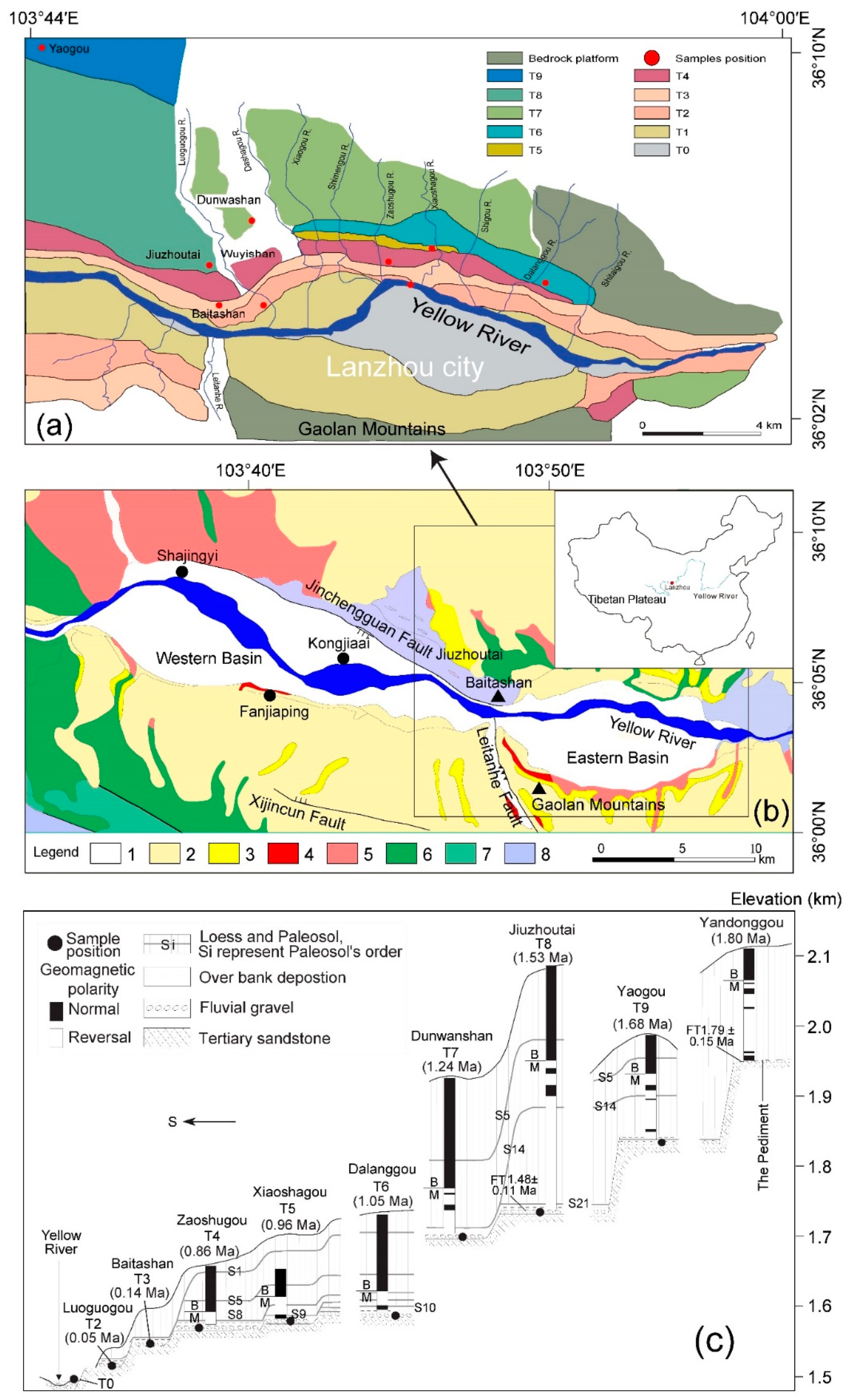
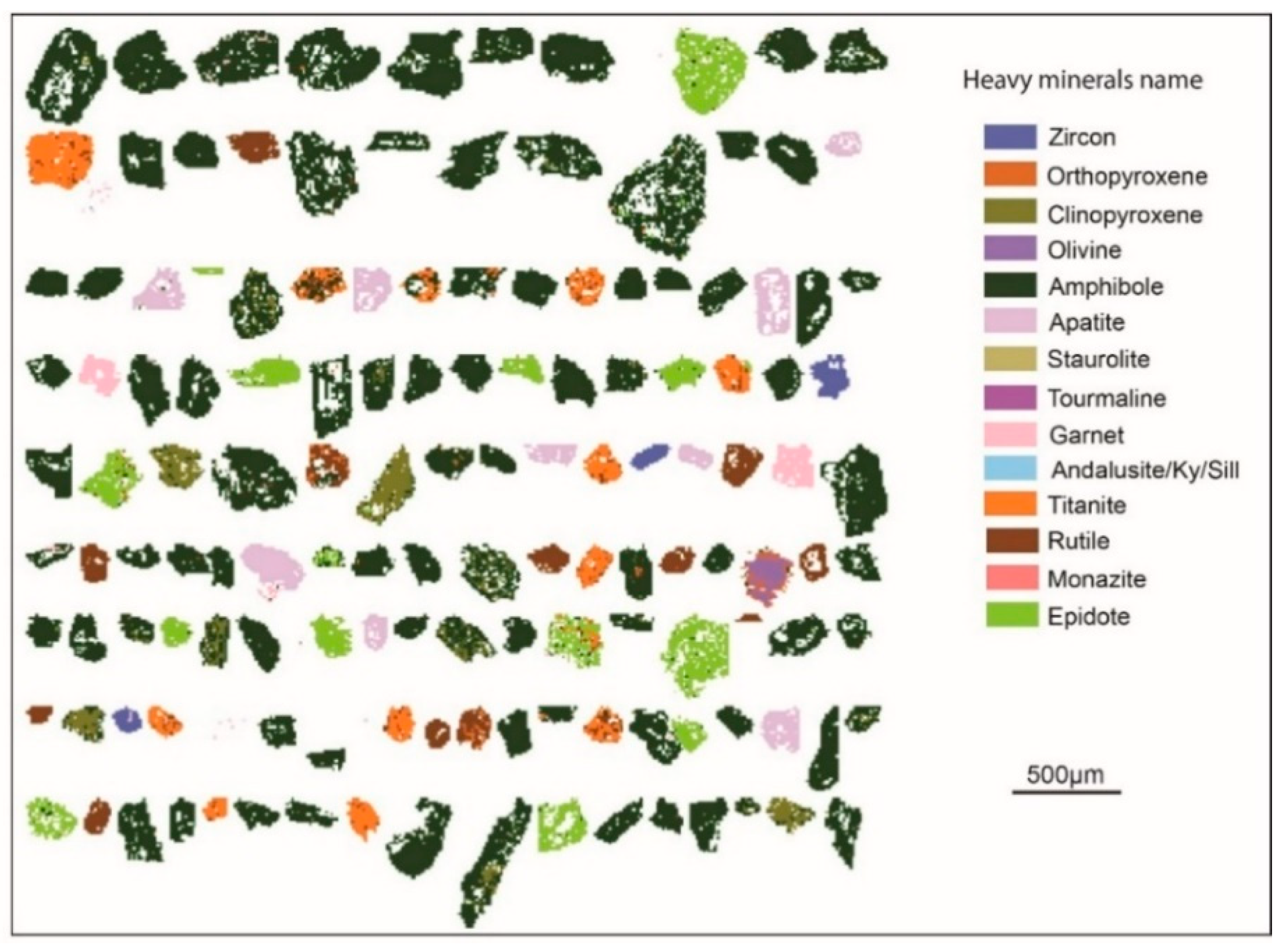
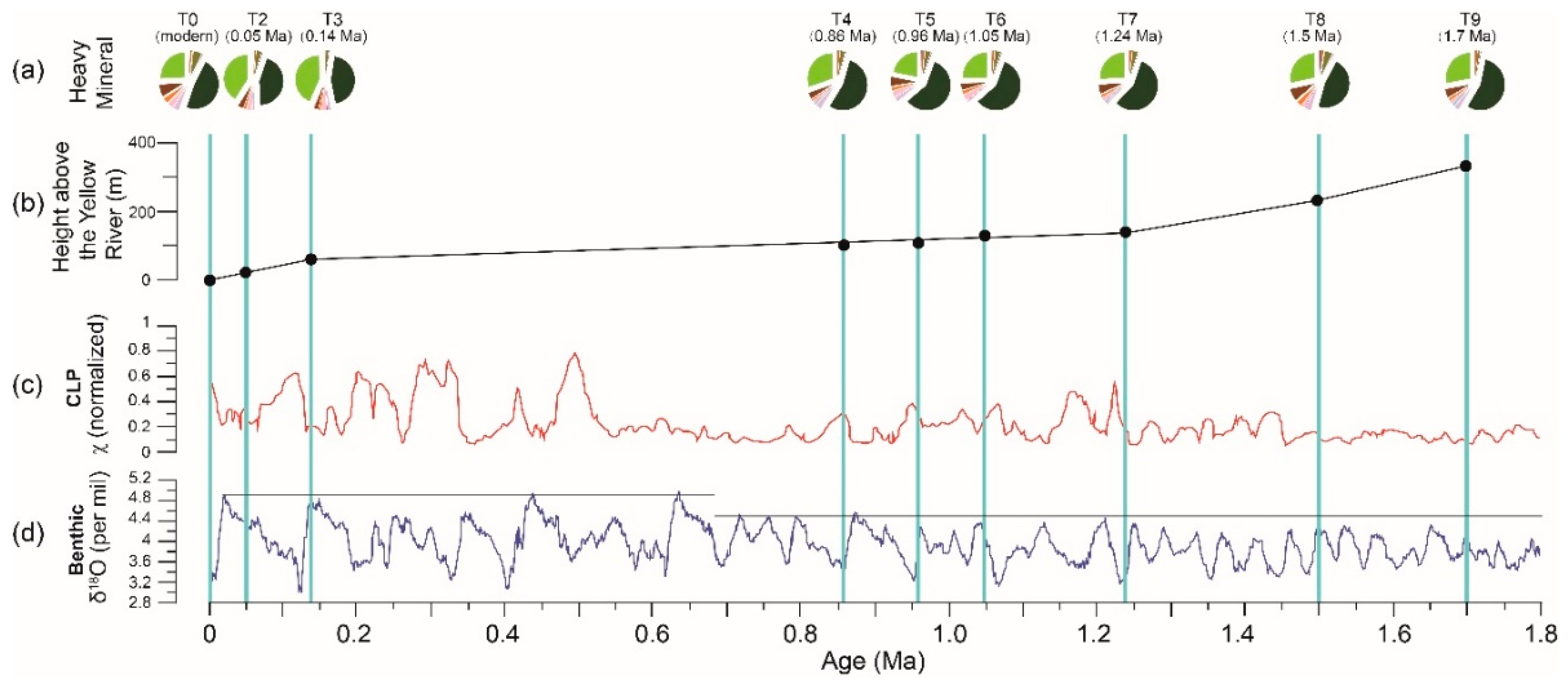
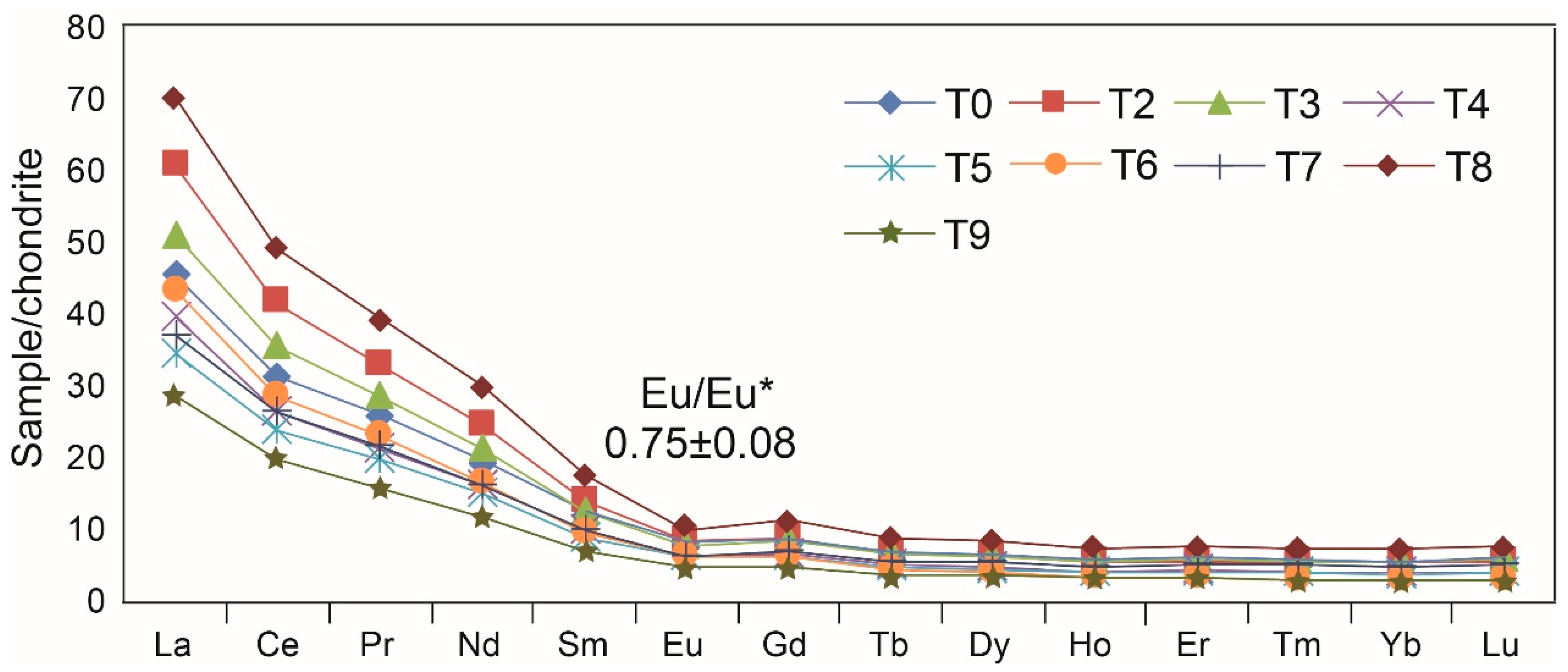
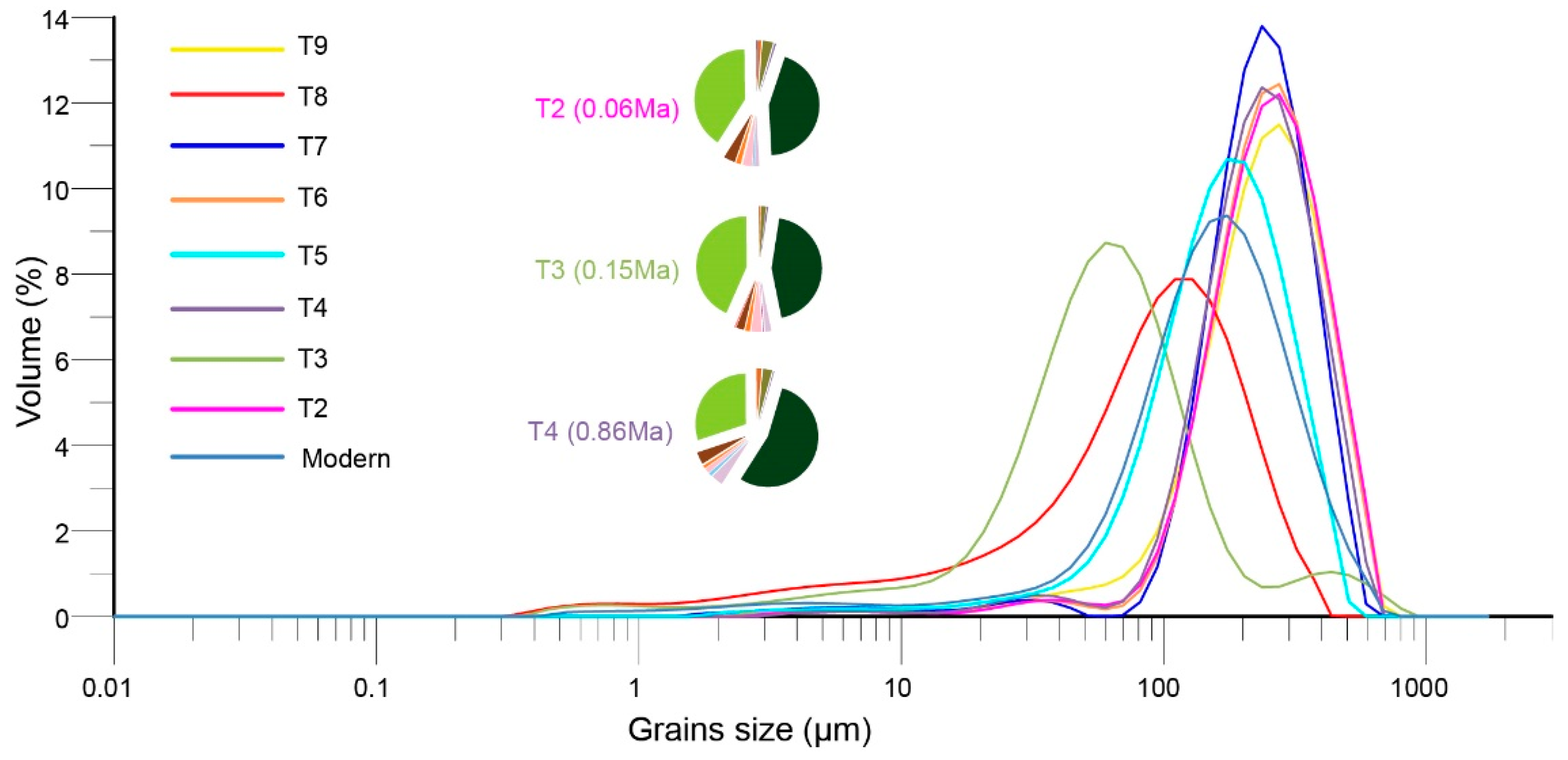
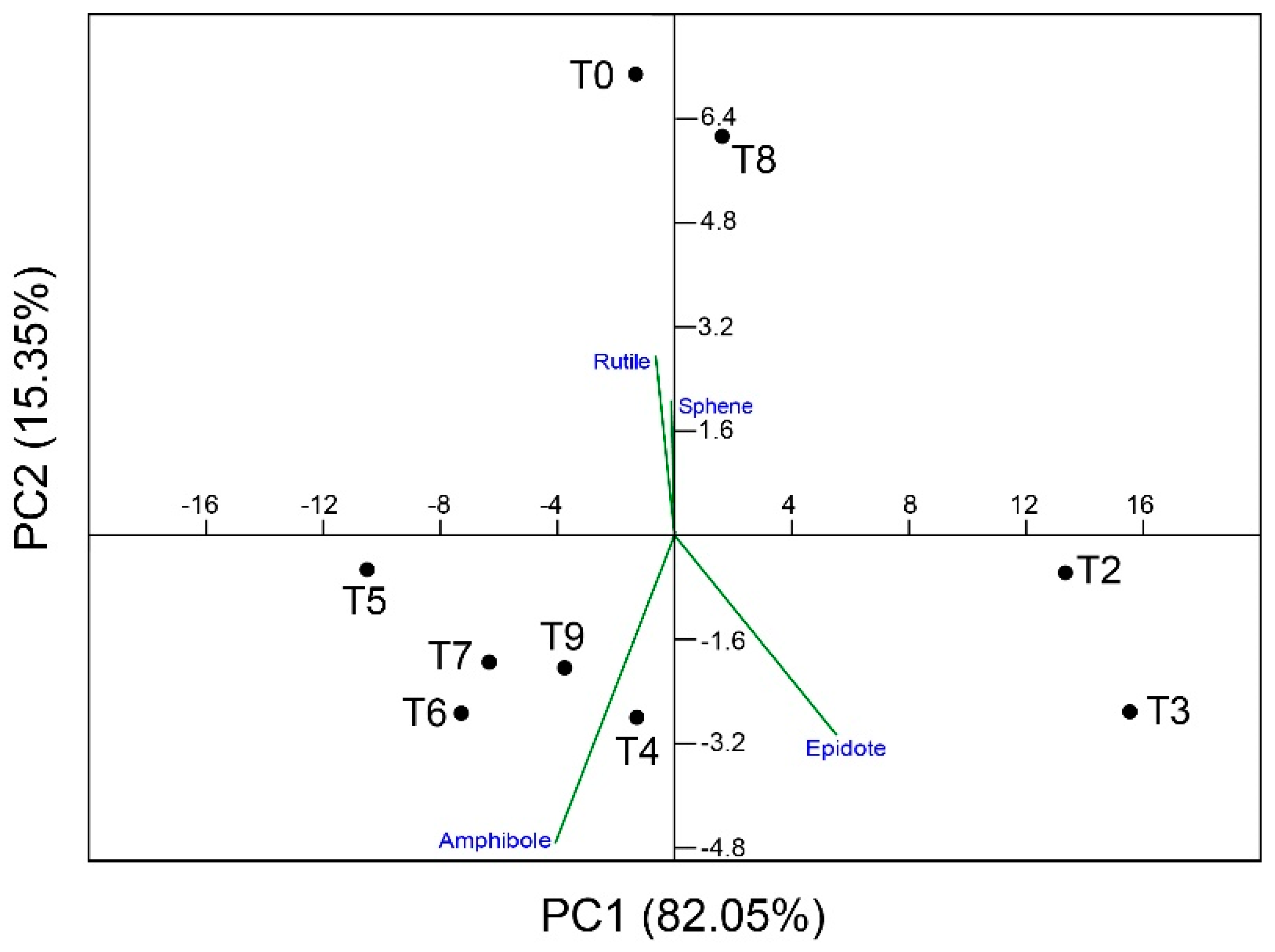
| Sample Number | Age | Zircon | Opx # | Cpx # | Olivine | Amphibole | Apatite | Andalusite /Ky/Sill# | Staurolite | Tourmaline | Garnet | Titanite | Rutile | Monazite | Epidote |
|---|---|---|---|---|---|---|---|---|---|---|---|---|---|---|---|
| T9 * | 1.70 Ma | 0 | 2 | 1 | 0 | 55 | 3 | 2 | 0 | 0 | 2 | 2 | 5 | 0 | 28 |
| T8 | 1.50 Ma | 0 | 2 | 5 | 0 | 46 | 4 | 0 | 0 | 0 | 2 | 3 | 8 | 0 | 29 |
| T7 | 1.24 Ma | 0 | 2 | 3 | 1 | 57 | 1 | 1 | 0 | 0 | 2 | 2 | 6 | 0 | 26 |
| T6 | 1.05 Ma | 1 | 2 | 3 | 1 | 58 | 1 | 0 | 0 | 0 | 4 | 2 | 4 | 0 | 25 |
| T5 | 0.96 Ma | 0 | 1 | 3 | 1 | 58 | 2 | 0 | 0 | 0 | 3 | 2 | 6 | 0 | 22 |
| T4 | 0.86 Ma | 0 | 2 | 3 | 0 | 54 | 3 | 1 | 0 | 0 | 1 | 1 | 4 | 0 | 30 |
| T3 | 0.14 Ma | 0 | 0 | 2 | 0 | 44 | 2 | 0 | 0 | 0 | 3 | 1 | 3 | 0 | 44 |
| T2 | 0.05 Ma | 0 | 1 | 3 | 0 | 44 | 1 | 0 | 0 | 0 | 3 | 1 | 4 | 0 | 41 |
| T0 | modern | 1 | 1 | 6 | 0 | 47 | 3 | 0 | 0 | 0 | 4 | 4 | 8 | 0 | 26 |
| Sample Number | Age | La | Ce | Pr | Nd | Sm | Eu | Gd | Tb | Dy | Ho | Er | Tm | Yb | Lu |
|---|---|---|---|---|---|---|---|---|---|---|---|---|---|---|---|
| T9 * | 1.70 Ma | 10.470 | 18.676 | 2.140 | 8.260 | 1.580 | 0.383 | 1.402 | 0.210 | 1.306 | 0.250 | 0.759 | 0.100 | 0.677 | 0.105 |
| T8 | 1.50 Ma | 25.715 | 47.243 | 5.410 | 21.115 | 3.985 | 0.832 | 3.412 | 0.497 | 3.068 | 0.597 | 1.839 | 0.254 | 1.744 | 0.280 |
| T7 | 1.24 Ma | 13.480 | 24.928 | 2.934 | 11.420 | 2.219 | 0.533 | 2.031 | 0.312 | 2.024 | 0.396 | 1.211 | 0.172 | 1.175 | 0.194 |
| T6 | 1.05 Ma | 15.838 | 27.250 | 3.112 | 11.699 | 2.141 | 0.519 | 1.789 | 0.238 | 1.389 | 0.257 | 0.744 | 0.103 | 0.687 | 0.105 |
| T5 | 0.96 Ma | 12.582 | 22.681 | 2.666 | 10.430 | 2.025 | 0.515 | 1.843 | 0.269 | 1.664 | 0.316 | 0.966 | 0.132 | 0.895 | 0.144 |
| T4 | 0.86 Ma | 14.512 | 24.976 | 2.892 | 11.228 | 2.202 | 0.533 | 1.939 | 0.281 | 1.733 | 0.331 | 1.016 | 0.138 | 0.937 | 0.150 |
| T3 | 0.14 Ma | 18.592 | 33.793 | 3.882 | 14.859 | 2.853 | 0.643 | 2.471 | 0.371 | 2.252 | 0.442 | 1.386 | 0.189 | 1.318 | 0.213 |
| T2 | 0.05 Ma | 22.269 | 39.731 | 4.508 | 17.364 | 3.184 | 0.731 | 2.630 | 0.375 | 2.314 | 0.450 | 1.314 | 0.189 | 1.268 | 0.203 |
| T0 | modern | 16.664 | 29.551 | 3.470 | 13.511 | 2.640 | 0.622 | 2.320 | 0.334 | 2.048 | 0.393 | 1.193 | 0.164 | 1.081 | 0.188 |
| chondrite | 0.367 | 0.957 | 0.137 | 0.711 | 0.231 | 0.087 | 0.306 | 0.058 | 0.381 | 0.0851 | 0.249 | 0.0356 | 0.248 | 0.0381 | |
© 2019 by the authors. Licensee MDPI, Basel, Switzerland. This article is an open access article distributed under the terms and conditions of the Creative Commons Attribution (CC BY) license (http://creativecommons.org/licenses/by/4.0/).
Share and Cite
Wang, Z.; Zhang, H.; Garzanti, E.; Nie, J.; Peng, W.; Andò, S.; Hu, X.; Pan, B.; Pfaff, K. Evolution of the Upper Yellow River as Revealed by Changes in Heavy-Mineral and Geochemical (REE) Signatures of Fluvial Terraces (Lanzhou, China). Minerals 2019, 9, 603. https://doi.org/10.3390/min9100603
Wang Z, Zhang H, Garzanti E, Nie J, Peng W, Andò S, Hu X, Pan B, Pfaff K. Evolution of the Upper Yellow River as Revealed by Changes in Heavy-Mineral and Geochemical (REE) Signatures of Fluvial Terraces (Lanzhou, China). Minerals. 2019; 9(10):603. https://doi.org/10.3390/min9100603
Chicago/Turabian StyleWang, Zhao, Haobo Zhang, Eduardo Garzanti, Junsheng Nie, Wenbin Peng, Sergio Andò, Xiaofei Hu, Baotian Pan, and Katharina Pfaff. 2019. "Evolution of the Upper Yellow River as Revealed by Changes in Heavy-Mineral and Geochemical (REE) Signatures of Fluvial Terraces (Lanzhou, China)" Minerals 9, no. 10: 603. https://doi.org/10.3390/min9100603
APA StyleWang, Z., Zhang, H., Garzanti, E., Nie, J., Peng, W., Andò, S., Hu, X., Pan, B., & Pfaff, K. (2019). Evolution of the Upper Yellow River as Revealed by Changes in Heavy-Mineral and Geochemical (REE) Signatures of Fluvial Terraces (Lanzhou, China). Minerals, 9(10), 603. https://doi.org/10.3390/min9100603






